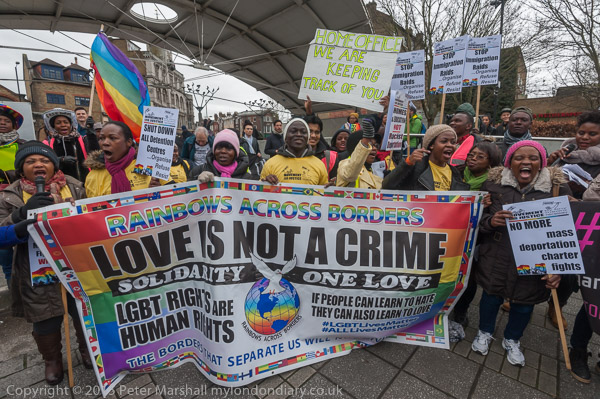Continuing my walk in Peckham in March 1989. The previous post on this walk was Asylum, Lorry Park, Works, Museum & Office Door.
I spent some time exploring the area around Malt Street and Ossory Road, now on the other side of Asda, where some demolition was taking place but took few photographs, none on-line, and then walked back along along the Old Kent Road to Peckham Park Road, going down this to Green Hundred Road. I found myself in a large area of council housing, much of which was fairly standard LCC five storey blocks dating from the late 1930s, solidly built, their height limited back then by the lack of lifts.
The foreground flats in this picture are from the late 60s and are on Bird in Bush Road, part of the GLC designed Ledbury Estate, and as well as these 4-storey maisonette blocks there were also four identical 14 floor H shape tower blocks, including this one, Bromyard House, which has its entrance on Commercial Way.
This picture was taken from close to the east end of Bird in Bush Road, and the building cut off at extreme left of the image is the former Arthur Street Board School (now Camelot Primary School.)
The design dates of these flats, also on the Ledbury estate, is from the early 1960s and was replicated across London by the GLC, using the prefabricated Danish Larsen-Nielsen system. After one at Ronan Point suffered a disastrous collapse following a gas explosion flats built using this system should have been strengthened, but somehow Southwark Council failed to do so on this estate. I’m not sure whether this had now been put right. but none have yet collapsed.
This semi-detached residence dating from 1836 which was Grade II listed together with the neighbouring Doddington Place around nine years after I took this picture.
The name possibly comes from Doddington Hall in Cheshire, built by Samuel Wyatt for Sir Thomas Broughton in 1777-90 and its parkland landscaped by Capability Brown. There is also Doddington Place at Doddington near Sittingbourne in Kent, but this was only built around 1870.
The Tustin Estate is on the north side the Old Kent Road immediately west of Ilderton Road. It has three 20 storey towers, Windermere Point, Grasmere Point (in the centre here) and Ambleside Point, each with over 70 flats which were approved by the GLC in 1964. There are also six low-rise blocks on the estate.
According to Southwark Council, “In March 2021, residents voted in favour of demolishing and rebuilding the low-rise buildings in a residents’ ballot. This will include replacement council homes, additional council homes and key worker housing, shared equity homes and homes for private sale. There will also be a replacement school building, new commercial spaces and a new park. All existing residents will be able to move to a new council home in the first phase of the scheme.” I’m unsure how far this scheme has so far progressed and it remains to be seen whether the council will keep its promises, which it almost completely failed to do on some earlier schemes.
I returned to Clifton Crescent which I had photographed earlier and too a rather better and closer picture of this magnificent curved terrace. As I explained earlier, it was Southwark Council’s decision in 1972 to demolish this crescent that led to a local action group which became the Peckham Society in 1975. Fortunately they managed to stop the demolition when only No 1 had been lost. They convinced the council that retaining and restoring the properties was a cheaper option, and the lost house was rebuilt and the entire crescent, Grade II listed thanks to their efforts in 1974, was restored by 1977. The Crescent was built in 1847-51 and represents an interesting transition between earlier Regency styles and the simpler Victorian terraces.
From there I made my way east, going under the railway on Culmore Road or Clifton Way and then south to Loder St. This whole area has been redeveloped since I made these pictures in 1989 and is now covered with low-rise housing. I made two pictures of this car breaker’s yard (you can see the other on Flickr).The tower blocks are those of the Tustin Estate.
I walked down to Queen’s Road, I think along York Grove, stopping briefly to photograph a street corner. On Queen’s Road before catching a bus I photographed the Hatcham Liberal Club, built in 1880 in Queen Anne Dutch style and Grade II listed ten years after I took this picture. It was one of the largest of a number of late Victorian working men’s clubs and became a popular venue with a large hall at the back available for hire for parties and gigs and also for until it closed in 2006. In 2009 most of the interior was converted into flats.
I changed buses in Camberwell, where I made a slight detour to make another visit to photograph the row of shops on John Ruskin Street as the final picture of the day and this walk.
The first post about this walk was Shops, Removals, Housing and the Pioneer Health Centre. I’ll post about my next walk in 1989, in the City of London, shortly.
























